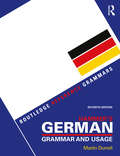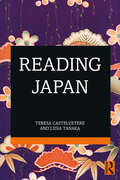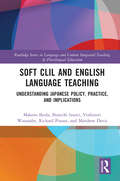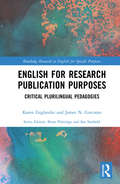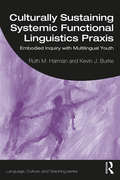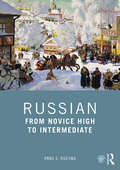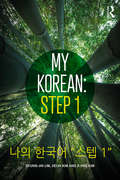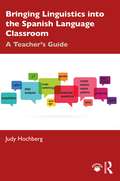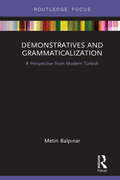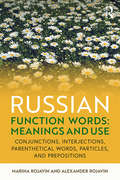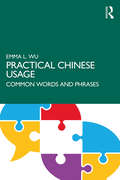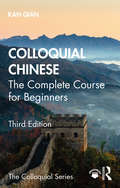- Table View
- List View
Hammer's German Grammar and Usage (Routledge Reference Grammars)
by Martin DurrellLong trusted as the most comprehensive, up-to-date and user-friendly grammar available, Hammer’s German Grammar and Usage provides you with a complete guide to German as it is written and spoken today. In a revised layout to improve ease of consultation, this new edition includes: concise descriptions of the main grammatical phenomena of German and their use completely reorganized tables of grammatical features examples of grammar taken from contemporary German, helping you to understand the underlying grammatical principles more quickly invaluable guidance on pronunciation and word stress discussion of new words from English roots, helping you to communicate in German as Germans do today clarification on current spellings of German with full detail on the most recent revisions to the rules list of useful internet resources for students, teachers and all learners of German Praised for its lucid explanations, this new edition explains and clearly distinguishes formal and informal spoken and written usage. Hammer’s German Grammar offers you a combination of reference grammar and manual of current usage that you will find invaluable, whether a student or a teacher, at intermediate or advanced level.
Hammer's German Grammar and Usage (Routledge Reference Grammars)
by Martin DurrellLong trusted as the most comprehensive, up-to-date and user-friendly grammar available, Hammer’s German Grammar and Usage provides you with a complete guide to German as it is written and spoken today. In a revised layout to improve ease of consultation, this new edition includes: concise descriptions of the main grammatical phenomena of German and their use completely reorganized tables of grammatical features examples of grammar taken from contemporary German, helping you to understand the underlying grammatical principles more quickly invaluable guidance on pronunciation and word stress discussion of new words from English roots, helping you to communicate in German as Germans do today clarification on current spellings of German with full detail on the most recent revisions to the rules list of useful internet resources for students, teachers and all learners of German Praised for its lucid explanations, this new edition explains and clearly distinguishes formal and informal spoken and written usage. Hammer’s German Grammar offers you a combination of reference grammar and manual of current usage that you will find invaluable, whether a student or a teacher, at intermediate or advanced level.
Reading Japan
by Teresa Castelvetere Lidia TanakaReading Japan offers the student readings on geopolitics, education, language, Japanese-ness and ethnicity, gender and history, with the dual aims of broadening students’ understanding of Japan and of providing opportunities to read authentic Japanese texts. Each chapter contains an essay in English, a selection of readings in Japanese, comprehensive vocabulary lists, discussion questions and a list of sources and additional readings. Pitched at Intermediate to Advanced and B1-C1 level, this reader is not simply a language textbook; it offers students a chance to learn and think in depth about Japan as they build confidence in reading real-world Japanese texts.
Soft CLIL and English Language Teaching: Understanding Japanese Policy, Practice and Implications (Routledge Series in Language and Content Integrated Teaching & Plurilingual Education)
by Makoto Ikeda Shinichi Izumi Yoshinori Watanabe Richard Pinner Matthew DavisContent and Language Integrated Learning (CLIL) is a transformative and powerful approach to language education and has had a significant impact on educational pedagogy in recent years. Despite burgeoning literature on the efficacy and implementation of CLIL, there remains a gap between CLIL and English Language Teaching (ELT). Many practitioners wonder how they can ‘do CLIL’ if their main classes are focused on English as a Foreign Language (EFL). This volume addresses these concerns by examining the experiences of various CLIL practitioners in the EFL context of Japan. Chapters outline the CLIL methodology, the differences in ‘hard CLIL’ (subject led) and ‘soft CLIL’ (language-oriented) before focusing on the EFL interpretations of soft-CLIL. Although the distinction of hard CLIL and soft CLIL has been mentioned in several publications, this is the first book-length exploration of this issue, featuring chapters examining expectations, challenges, material support, implementation, and even motivation in CLIL classrooms. All of this culminates in a review of the potential and future of CLIL in EFL contexts, paving the way for more widespread and well informed implementation of CLIL all over the world.
English for Research Publication Purposes: Critical Plurilingual Pedagogies (Routledge Research in English for Specific Purposes)
by Karen Englander James N. CorcoranScholars who use English as an additional language confront challenges when disseminating their research in the global market of knowledge production dominated by English. English for Research Publication Purposes analyses the experiences and practices of these scholars across the globe and presents "critical plurilingual pedagogies" as a theoretically and empirically informed means of supporting them. This book: • Draws on an empirical study of a Latin American university’s effort to mount a course that provides support to emerging and established scholars who use English as an additional language; • Brings theoretically informed discussions of critical pedagogies, plurilingualism and identity affirmation to better serve plurilingual scholars who seek to publish their research in English-language journals; • Provides examples of classroom activities that can be adapted and adopted to local contexts and realities in a curriculum based on critical plurilingual pedagogies; • Proposes future directions for research into the internationally urgent, growing concerns of global scholars who produce English-medium academic knowledge for the world stage. Incisive and cutting-edge, English for Research Publication Purposes will be key reading for academics and upper-level students working in the areas of ESP, EAP, ERPP, and Applied Linguistics.
Soft CLIL and English Language Teaching: Understanding Japanese Policy, Practice and Implications (Routledge Series in Language and Content Integrated Teaching & Plurilingual Education)
by Makoto Ikeda Shinichi Izumi Yoshinori Watanabe Richard Pinner Matthew DavisContent and Language Integrated Learning (CLIL) is a transformative and powerful approach to language education and has had a significant impact on educational pedagogy in recent years. Despite burgeoning literature on the efficacy and implementation of CLIL, there remains a gap between CLIL and English Language Teaching (ELT). Many practitioners wonder how they can ‘do CLIL’ if their main classes are focused on English as a Foreign Language (EFL). This volume addresses these concerns by examining the experiences of various CLIL practitioners in the EFL context of Japan. Chapters outline the CLIL methodology, the differences in ‘hard CLIL’ (subject led) and ‘soft CLIL’ (language-oriented) before focusing on the EFL interpretations of soft-CLIL. Although the distinction of hard CLIL and soft CLIL has been mentioned in several publications, this is the first book-length exploration of this issue, featuring chapters examining expectations, challenges, material support, implementation, and even motivation in CLIL classrooms. All of this culminates in a review of the potential and future of CLIL in EFL contexts, paving the way for more widespread and well informed implementation of CLIL all over the world.
English for Research Publication Purposes: Critical Plurilingual Pedagogies (Routledge Research in English for Specific Purposes)
by Karen Englander James N. CorcoranScholars who use English as an additional language confront challenges when disseminating their research in the global market of knowledge production dominated by English. English for Research Publication Purposes analyses the experiences and practices of these scholars across the globe and presents "critical plurilingual pedagogies" as a theoretically and empirically informed means of supporting them. This book: • Draws on an empirical study of a Latin American university’s effort to mount a course that provides support to emerging and established scholars who use English as an additional language; • Brings theoretically informed discussions of critical pedagogies, plurilingualism and identity affirmation to better serve plurilingual scholars who seek to publish their research in English-language journals; • Provides examples of classroom activities that can be adapted and adopted to local contexts and realities in a curriculum based on critical plurilingual pedagogies; • Proposes future directions for research into the internationally urgent, growing concerns of global scholars who produce English-medium academic knowledge for the world stage. Incisive and cutting-edge, English for Research Publication Purposes will be key reading for academics and upper-level students working in the areas of ESP, EAP, ERPP, and Applied Linguistics.
Culturally Sustaining Systemic Functional Linguistics Praxis: Embodied Inquiry with Multilingual Youth (Language, Culture, and Teaching Series)
by Kevin J. Burke Ruth M. HarmanBy introducing a framework for culturally sustaining Systemic Functional Linguistics (SFL) praxis, Harman, Burke and other contributing authors guide readers through a practical and analytic exploration of youth participatory work in classroom and community settings. Applying an SFL lens to critical literacy and schooling, this book articulates a vision for youth learning and civic engagement that focuses on the power of performance, spatial learning, community activism and student agency. The book offers a range of research-driven, multimodal resources and methods for teachers to encourage students’ meaning-making. The authors share how teachers and community activists can interact and support diverse and multilingual youth, fostering a dynamic environment that deepens inquiry of the arts and disciplinary area of knowledge. Research in this book provides a model for collaborative engagement and community partnerships, featuring the voices of students and teachers to highlight the importance of agency and action research in supporting literacy learning and transformative inquiry. Demonstrating theoretically and practically how SFL praxis can be applied broadly and deeply in the field, this book is suitable for preservice teachers, teacher educators, graduate students and scholars in bilingual and multilingual education, literacy education and language policy.
Culturally Sustaining Systemic Functional Linguistics Praxis: Embodied Inquiry with Multilingual Youth (Language, Culture, and Teaching Series)
by Kevin J. Burke Ruth M. HarmanBy introducing a framework for culturally sustaining Systemic Functional Linguistics (SFL) praxis, Harman, Burke and other contributing authors guide readers through a practical and analytic exploration of youth participatory work in classroom and community settings. Applying an SFL lens to critical literacy and schooling, this book articulates a vision for youth learning and civic engagement that focuses on the power of performance, spatial learning, community activism and student agency. The book offers a range of research-driven, multimodal resources and methods for teachers to encourage students’ meaning-making. The authors share how teachers and community activists can interact and support diverse and multilingual youth, fostering a dynamic environment that deepens inquiry of the arts and disciplinary area of knowledge. Research in this book provides a model for collaborative engagement and community partnerships, featuring the voices of students and teachers to highlight the importance of agency and action research in supporting literacy learning and transformative inquiry. Demonstrating theoretically and practically how SFL praxis can be applied broadly and deeply in the field, this book is suitable for preservice teachers, teacher educators, graduate students and scholars in bilingual and multilingual education, literacy education and language policy.
Russian: From Novice High to Intermediate
by Anna S. KudymaRussian: From Novice High to Intermediate is a multi-level course that presents grammar, vocabulary, culture, music, film, and literature within the context of Russian life. With a flexible modular approach structured around contemporary themes, this course builds on students’ reading, listening, speaking, and writing skills while also expanding their cultural literacy. Each chapter contains projects and scenarios that enable language learners to practice and demonstrate communicative competence. An interactive website full of videos, audio, and self-correcting exercises accompanies the course and can be accessed through www.routledge.com/9780367137137. This comprehensive resource is ideal for use in second- and third-year Russian classes.
Russian: From Novice High to Intermediate
by Anna S. KudymaRussian: From Novice High to Intermediate is a multi-level course that presents grammar, vocabulary, culture, music, film, and literature within the context of Russian life. With a flexible modular approach structured around contemporary themes, this course builds on students’ reading, listening, speaking, and writing skills while also expanding their cultural literacy. Each chapter contains projects and scenarios that enable language learners to practice and demonstrate communicative competence. An interactive website full of videos, audio, and self-correcting exercises accompanies the course and can be accessed through www.routledge.com/9780367137137. This comprehensive resource is ideal for use in second- and third-year Russian classes.
My Korean: 나의 한국어 “스텝 1”
by Byung-jin Lim Jieun Kim Ji-Hye KimThe My Korean series of textbooks offers a learner-centred, communicative task-based, interactive approach to learning contemporary Korean. My Korean: Step 1 and My Korean: Step 2 are arranged thematically around topics that any novice learner of Korean is likely to encounter in their first year of study. Each lesson contains two dialogues showing contemporary Korean in use, followed by succinct grammar and vocabulary explanations. The focus throughout the books is on communicative in-class activities and tasks that encourage students’ active participation. Video clips of the lesson dialogues are available as an online resource, and each unit contains communicative activities based on the dialogue themes. The engaging structure and communicative approach make My Korean: Step 1 an ideal text for first semester Korean courses. It is also a great resource for individual study or one-on-one tutorials on Korean language and culture.
Bringing Linguistics into the Spanish Language Classroom: A Teacher's Guide
by Judy HochbergBringing Linguistics into the Spanish Language Classroom is a practical, time-saving resource that allows teachers to easily integrate the most interesting and important findings of Hispanic linguistics into their Spanish language classes. Teachers will find classroom-ready explanations and PowerPoint slides for each topic covered, as well as instructions and materials for in-class activities and take-home projects that will engage students in this fresh take on the target language. Slide presentations for each chapter are available online at www.routledge.com/9780367111960. The book covers aspects of Spanish from the trilled r to the personal a, from Indo-European origins to modern dialects, and from children’s first words to adult speech errors. An innovative set of five linguistics-based essential questions organizes and contextualizes this wide range of material: How is Spanish different from other languages? How is Spanish similar to other languages? What are the roots of Spanish? How does Spanish vary? How do people learn and use Spanish? Fully customizable to teacher and student interest, proficiency level, and time available in class, this book is ideal for Spanish language teachers looking to incorporate valuable linguistic insights into their curricula, even if they lack prior knowledge of this field. It is an excellent resource for Hispanic linguistics courses as well.
Demonstratives and Grammaticalization: A Perspective from Modern Turkish
by Metin BalpınarDemonstratives and Grammaticalization offers an in-depth analysis of the demonstrative system in Turkish. This book provides the first comprehensive analysis dealing with both the synchronic variations in Turkish demonstratives and their grammatical changes. It sheds light on the syntactic, semantic, and pragmatic properties of the demonstratives, systematically describes the various usages of these forms, and provides a unified explanation for the various accounts of their distribution. While the focus is on Turkish, this analysis contributes to our understanding of how a demonstrative system operates in a language with a three-way distinction.
Russian Function Words: Conjunctions, Interjections, Parenthetical Words, Particles, and Prepositions
by Marina Rojavin Alexander RojavinRussian Function Words: Meanings and Use is a collection of 463 prepositions, conjunctions, particles, interjections, and parenthetical words. This book provides a semantic, syntactic, and stylistic analysis of each word, accompanying the explanation with examples of the word’s usage in discourse in contemporary, everyday Russian and analogous translations into English. Consequently, it allows users to develop an understanding of contemporary grammatical, lexical, and stylistic norms, with the aim of mastering these critical words. This book also includes a multitude of idioms and sayings that users will learn to use in the appropriate context. Intermediate and advanced students, instructors, and translators will find this a useful supplement to their existing resources. It also serves as a helpful reference for independent learners at all levels.
Bringing Linguistics into the Spanish Language Classroom: A Teacher's Guide
by Judy HochbergBringing Linguistics into the Spanish Language Classroom is a practical, time-saving resource that allows teachers to easily integrate the most interesting and important findings of Hispanic linguistics into their Spanish language classes. Teachers will find classroom-ready explanations and PowerPoint slides for each topic covered, as well as instructions and materials for in-class activities and take-home projects that will engage students in this fresh take on the target language. Slide presentations for each chapter are available online at www.routledge.com/9780367111960. The book covers aspects of Spanish from the trilled r to the personal a, from Indo-European origins to modern dialects, and from children’s first words to adult speech errors. An innovative set of five linguistics-based essential questions organizes and contextualizes this wide range of material: How is Spanish different from other languages? How is Spanish similar to other languages? What are the roots of Spanish? How does Spanish vary? How do people learn and use Spanish? Fully customizable to teacher and student interest, proficiency level, and time available in class, this book is ideal for Spanish language teachers looking to incorporate valuable linguistic insights into their curricula, even if they lack prior knowledge of this field. It is an excellent resource for Hispanic linguistics courses as well.
Demonstratives and Grammaticalization: A Perspective from Modern Turkish
by Metin BalpınarDemonstratives and Grammaticalization offers an in-depth analysis of the demonstrative system in Turkish. This book provides the first comprehensive analysis dealing with both the synchronic variations in Turkish demonstratives and their grammatical changes. It sheds light on the syntactic, semantic, and pragmatic properties of the demonstratives, systematically describes the various usages of these forms, and provides a unified explanation for the various accounts of their distribution. While the focus is on Turkish, this analysis contributes to our understanding of how a demonstrative system operates in a language with a three-way distinction.
Russian Function Words: Conjunctions, Interjections, Parenthetical Words, Particles, and Prepositions
by Marina Rojavin Alexander RojavinRussian Function Words: Meanings and Use is a collection of 463 prepositions, conjunctions, particles, interjections, and parenthetical words. This book provides a semantic, syntactic, and stylistic analysis of each word, accompanying the explanation with examples of the word’s usage in discourse in contemporary, everyday Russian and analogous translations into English. Consequently, it allows users to develop an understanding of contemporary grammatical, lexical, and stylistic norms, with the aim of mastering these critical words. This book also includes a multitude of idioms and sayings that users will learn to use in the appropriate context. Intermediate and advanced students, instructors, and translators will find this a useful supplement to their existing resources. It also serves as a helpful reference for independent learners at all levels.
Tondano: A Grammar Sketch of an Endangered Minahasan Language (Routledge World Languages)
by Timothy C. BrickellThis monograph is a grammatical description of Tondano, an endangered and under-documented Austronesian (AN) language spoken in the northern part of the island of Sulawesi, Indonesia. It is a modified version of the related doctoral dissertation completed at La Trobe University, Bundoora, Victoria, Australia (2015). The chapters herein begin by outlining relevant socio-historical information relating to the Tondano speech community, before providing detailed explanations of the sound system (phonetics and phonology), word structure (morphology), and phrase and sentence structure (syntax) of the language. This description seeks to be as complete as possible, while at the same time acknowledging any descriptive shortcomings, either due to a lack of data, a lack of analytical clarity, or simply due to considerations of space. The data used for this grammar come from extensive in situ fieldwork (2011–2015). In essence, the analysis takes a theory-neutral approach. While it does not utilise a specific theoretical framework, parts of the terminology, methodology, and analysis conform to those of Basic Linguistic Theory. There is a strong emphasis on using data which are as naturalistic as possible, and which has been collected, collated, and analysed in collaboration with native speakers in the Tondano speech community. For all levels of linguistic structure under description, language examples taken from primarily spontaneous communicative events are provided. In terms of issues relating to Austronesian typology, and aspects of broader cross-linguistic typology, these are mentioned where deemed necessary but are not the primary focus of this work. The principal audience for this book is scholars and students of languages and linguistics, along with anyone with an interest in the anthropology and linguistics of the Austronesian cultures of Maritime Southeast Asia.
Tondano: A Grammar Sketch of an Endangered Minahasan Language (Routledge World Languages)
by Timothy C. BrickellThis monograph is a grammatical description of Tondano, an endangered and under-documented Austronesian (AN) language spoken in the northern part of the island of Sulawesi, Indonesia. It is a modified version of the related doctoral dissertation completed at La Trobe University, Bundoora, Victoria, Australia (2015). The chapters herein begin by outlining relevant socio-historical information relating to the Tondano speech community, before providing detailed explanations of the sound system (phonetics and phonology), word structure (morphology), and phrase and sentence structure (syntax) of the language. This description seeks to be as complete as possible, while at the same time acknowledging any descriptive shortcomings, either due to a lack of data, a lack of analytical clarity, or simply due to considerations of space. The data used for this grammar come from extensive in situ fieldwork (2011–2015). In essence, the analysis takes a theory-neutral approach. While it does not utilise a specific theoretical framework, parts of the terminology, methodology, and analysis conform to those of Basic Linguistic Theory. There is a strong emphasis on using data which are as naturalistic as possible, and which has been collected, collated, and analysed in collaboration with native speakers in the Tondano speech community. For all levels of linguistic structure under description, language examples taken from primarily spontaneous communicative events are provided. In terms of issues relating to Austronesian typology, and aspects of broader cross-linguistic typology, these are mentioned where deemed necessary but are not the primary focus of this work. The principal audience for this book is scholars and students of languages and linguistics, along with anyone with an interest in the anthropology and linguistics of the Austronesian cultures of Maritime Southeast Asia.
Practical Chinese Usage: Common Words and Phrases
by Emma L. WuPractical Chinese Usage offers post-beginner to near advanced students of Chinese a guide to the most frequently misused and confusing words in the language. Entries are arranged in alphabetical order for ease of reference. Sample sentences with pinyin and English translations are provided after each explanation. Examples of typical mistakes made by students are clearly marked throughou. Each entry is annotated in accordance with the New HSK guidelines, indicating the level of difficulty. Practical Chinese Usage provides students of Chinese with the necessary tools to refine their use of expressions and synonyms in order to communicate effectively in the Chinese language.
Australian English Reimagined: Structure, Features and Developments (Routledge Studies in World Englishes)
by Louisa Willoughby Howard MannsAustralian English is perhaps best known for its colourful slang, but the variety is much richer than slang alone. This collection provides a detailed account of Australian English by bringing together leading scholars of this English variety. These scholars provide a comprehensive overview of Australian English’s distinctive features and outline cutting-edge research into the variation and change of English in Australia. Organised thematically, this volume explores the ways in which Australian English differs from other varieties of English, as well as examining regional, social and stylistic variation within the variety. The volume first explores particular structural features where Australian English differentiates itself from other English varieties. There are chapters on phonetics and phonology, socio-phonetics, lexicon and discourse-pragmatics as these elements are core to understanding any variety of English, especially within the World Englishes paradigm. It then considers what are arguably the most salient aspects of variation within Australian English and finally focuses on historical, attitudinal and planning aspects of Australian English. This volume provides a thorough account of Australian English and its users as complex, diverse and worthy of study. Perhaps more importantly, this volume’s scholars provide a reimagining of Australian English and the paradigm through which future scholars may proceed.
Australian English Reimagined: Structure, Features and Developments (Routledge Studies in World Englishes)
by Louisa Willoughby Howard MannsAustralian English is perhaps best known for its colourful slang, but the variety is much richer than slang alone. This collection provides a detailed account of Australian English by bringing together leading scholars of this English variety. These scholars provide a comprehensive overview of Australian English’s distinctive features and outline cutting-edge research into the variation and change of English in Australia. Organised thematically, this volume explores the ways in which Australian English differs from other varieties of English, as well as examining regional, social and stylistic variation within the variety. The volume first explores particular structural features where Australian English differentiates itself from other English varieties. There are chapters on phonetics and phonology, socio-phonetics, lexicon and discourse-pragmatics as these elements are core to understanding any variety of English, especially within the World Englishes paradigm. It then considers what are arguably the most salient aspects of variation within Australian English and finally focuses on historical, attitudinal and planning aspects of Australian English. This volume provides a thorough account of Australian English and its users as complex, diverse and worthy of study. Perhaps more importantly, this volume’s scholars provide a reimagining of Australian English and the paradigm through which future scholars may proceed.
Colloquial Chinese: The Complete Course for Beginners
by Qian KanColloquial Chinese: The Complete Course for Beginners has been carefully developed by a leading academic in Chinese language teaching and course design. Based on feedback from learners and teachers who used its previous version, this new edition has been updated to reflect the language and cultural changes in China, such as online shopping and WeChat payment, and to provide a more integrated and step-by-step approach to making the learning of modern Mandarin Chinese more effective and enjoyable. Combining a clear, practical and accessible style with a methodical and thorough treatment of the language, it equips learners with the essential knowledge and skills needed to communicate confidently and effectively in Chinese in a broad range of situations. No prior knowledge of the language is required. Colloquial Chinese is exceptional; each unit presents a wealth of grammatical points that are reinforced with a wide range of exercises for regular practice. A full answer key, a grammar summary, bilingual glossaries and English translations of dialogues can be found at the back, as well as transcripts of listening practice exercises. Key features include: A clear, user-friendly format designed to help learners progressively build up their speaking, listening, reading and writing skills Jargon-free, succinct and clearly structured explanations of grammar Step by step introduction of Chinese characters An extensive range of focused and dynamic supportive exercises A combination of listening, reading and speaking activities with the support of transcripts at the back of the book Realistic and entertaining dialogues covering a broad variety of narrative situations Helpful cultural points explaining the customs and features of life in China An overview of the Chinese language: its sounds, structure and Chinese characters Balanced, comprehensive and rewarding, Colloquial Chinese is an indispensable resource both for independent learners and students taking courses in Chinese as well as teachers of Chinese. Audio material to accompany the course is available to download free in MP3 format from www.routledge.com/cw/colloquials. Recorded by native speakers, the audio material features the dialogues, new words and listening practice exercises from the book and will help develop your listening and speaking skills.
Colloquial Chinese: The Complete Course for Beginners
by Qian KanColloquial Chinese: The Complete Course for Beginners has been carefully developed by a leading academic in Chinese language teaching and course design. Based on feedback from learners and teachers who used its previous version, this new edition has been updated to reflect the language and cultural changes in China, such as online shopping and WeChat payment, and to provide a more integrated and step-by-step approach to making the learning of modern Mandarin Chinese more effective and enjoyable. Combining a clear, practical and accessible style with a methodical and thorough treatment of the language, it equips learners with the essential knowledge and skills needed to communicate confidently and effectively in Chinese in a broad range of situations. No prior knowledge of the language is required. Colloquial Chinese is exceptional; each unit presents a wealth of grammatical points that are reinforced with a wide range of exercises for regular practice. A full answer key, a grammar summary, bilingual glossaries and English translations of dialogues can be found at the back, as well as transcripts of listening practice exercises. Key features include: A clear, user-friendly format designed to help learners progressively build up their speaking, listening, reading and writing skills Jargon-free, succinct and clearly structured explanations of grammar Step by step introduction of Chinese characters An extensive range of focused and dynamic supportive exercises A combination of listening, reading and speaking activities with the support of transcripts at the back of the book Realistic and entertaining dialogues covering a broad variety of narrative situations Helpful cultural points explaining the customs and features of life in China An overview of the Chinese language: its sounds, structure and Chinese characters Balanced, comprehensive and rewarding, Colloquial Chinese is an indispensable resource both for independent learners and students taking courses in Chinese as well as teachers of Chinese. Audio material to accompany the course is available to download free in MP3 format from www.routledge.com/cw/colloquials. Recorded by native speakers, the audio material features the dialogues, new words and listening practice exercises from the book and will help develop your listening and speaking skills.
